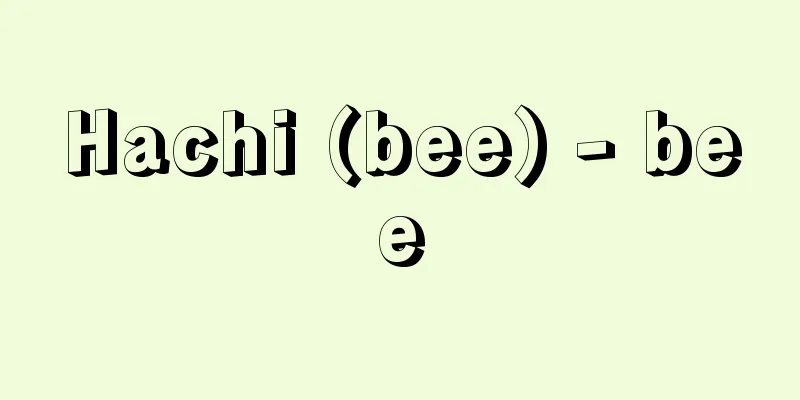Beat - Beat

〘 noun 〙 [1] A word used in music. ① A division into a certain number of beats in the progression of a melody. It forms the basis of rhythm. Depending on the relationship between the number of beats and the strength of the sound, it is called a two-beat, three-beat, four-beat, etc. In Japanese music, gagaku has types such as nobe beat, hay beat, tada beat, and yatara (hatara) beat. Ma beat means rhythm. Houshi. ※Utsubo (around 970-999) Rojojo: "He was more and more moved, and had the Emperor beat his fan." ② A unit of measurement for the progression of a piece of music. In gagaku, it refers to the strong beating of a drum, which is the unit for counting musical phrases. ③ One of the instruments used in gagaku, such as Kagura , Saibara , and Azuma Asobi . A board that is shaped like a shaku (Japanese scepter) split vertically into two pieces and clapped together. The lead singer of a song holds it to keep the beat. Shakubyōshi (Japanese scepter beat) . Also, a player who holds a shakubyōshi (Japanese scepter beat). Hōshi. ※Genji (around 1001-14), Kagurabi (Ben no Shosho), "The voice of the hyōushi (bow) comes out of the mouth of the scepter and sings softly and gently." ④ In Nohgaku and other music, this refers to musical instruments. The four drums are the flute, the small drum, the large drum, and the taiko drum. ※Warambegusa (1660), 4, "The one who is in tune with the beat is a common one, and I particularly dislike it." ⑤ In Nohgaku and dance, this refers to foot beats. ※Sarugakudangi (1430), Yorozu no monomane wa kokoro (Japanese imitation of all things is the heart) "At Funabashi in Sano, 'night after night,' I step on the same, it's the same, very important hyōushi." [2] Acoustic expression or the tone or momentum of something. ① The act of beating a drum or wooden clappers to warn or signal. ※Ukiyo-zoshi, Koshoku Seisui-ki (1688), 3 "When the evening breeze touches my fire-watching spirit, I take the drum as my own and naturally learn the three beats." ② In haiku, this is one of the seven items in the Shiko verse. It is added based on the momentum of the previous verse's sound. [Haikai, Haikai Jūron (1719)] ③ The momentum with which something moves forward. The way things move forward. The tone. ※Shiji-sho (1477), 18 "I was so out of character that I was so rude that I struck my head and feet." ④ The enthusiasm with which something is done. ※Shoō Dohwa (1814-46), 3 "When you take something from someone who is too honest, there's no rhythm to it." ⑤ The exact moment when something is done. The momentum. Suddenly. ※Shiji Sho (1477), 6: "It leaps forward and slashes its throat, with its left hand on the horse." [3] A type of omogai ( face covering) worn by horses used as porters. It is a long, thin board attached to the left and right sides of the horse's face, and is secured by a rope tied around its nose. It is also called hyoushi omozura or hyoushi nose leather. [Nippo Jisho (1603-04)] [Additional note] Originally a Chinese word representing the name of a musical instrument that was introduced to Japan before the Heian period, it is also called "haku," and is thought to have been a type of " hakuhan" (a musical instrument made of several stacked boards connected by strings of tanned leather).Ho-shi hau… [beat]Source: The Selected Edition of the Japanese Language Dictionary About the Selected Edition of the Japanese Language Dictionary Information |
〘名〙[一] 音楽で用いる語。① 旋律の進行に際し、一定の拍(はく)をひとかたまりにして区切ったもの。リズムの基礎をなす。拍の数と強弱の関係により、二拍子、三拍子、四拍子などという。日本音楽では、雅楽に延(のべ)拍子、早拍子、只(ただ)拍子、夜多良(八多良)拍子などの種類がある。間(ま)拍子はリズムの意味。ほうし。※宇津保(970‐999頃)楼上下「いよいよあはれがらせ給て、御扇してひゃうし打たせ給ふ」② 楽曲の進行の時間を測る単位。雅楽では、楽句を数える単位となる太鼓の強打音をいう。③ 神楽(かぐら)、催馬楽(さいばら)、東遊(あずまあそび)など雅楽で用いる楽器の一つ。笏(しゃく)を縦に二分したような形の板を打ち合わせるもの。歌の主唱者がこれを持って拍節をとる。笏拍子(しゃくびょうし)。また、笏拍子を持つ奏者。ほうし。※源氏(1001‐14頃)篝火「弁の少将ひゃうし打ちいでて、しのびやかにうたふ声」④ 能楽などで、楽器のこと。笛・小鼓・大鼓・太鼓を四拍子という。※わらんべ草(1660)四「よく拍子にあふは、みなしたるき位にて、殊の外きらふ也」⑤ 能楽・舞踊で、足拍子のこと。※申楽談儀(1430)よろづの物まねは心根「佐野の船橋に『宵々に』、ちゃうど踏む、同じ、いと大事のひゃうし也」[二] 音響表現や物事の調子・勢い。① 警戒や合図のために、太鼓や拍子木などを打つこと。※浮世草子・好色盛衰記(1688)三「夕風に火用心を触、太鼓は我物にして、自然と三つ拍子(ビョウシ)を覚へ」② 俳諧で、支考の付合七品目の一つ。前句の語呂の勢いに乗って付けるもの。〔俳諧・俳諧十論(1719)〕③ 物事の進む勢い。進みぐあい。調子。※史記抄(1477)一八「字が不足してひゃうしがわるさに首頭足とをいたぞ」④ 物事をするはりあい。※松翁道話(1814‐46)三「正直過ぎる人のものは、取っても拍子がない」⑤ 何かが行なわれたちょうどその時。はずみ。とたん。※史記抄(1477)六「活と前へはねて喉ふえをはねきるひゃうしに左手を以て」[三] 小荷駄用の引馬の面掛(おもがい)の一種。馬の顔の左右につける細長い板で、鼻づらから縄をかけてとめる。拍子覊(ひょうしおもづら)、拍子鼻革ともいう。〔日葡辞書(1603‐04)〕[補注]もとは平安時代以前に日本にはいってきた楽器名を表わす漢語で、「拍」ともいい、「拍板(はくはん)」(板を何枚か重ね、なめし皮の紐でつないだ楽器)の類であろうと考えられる。
ほう‐し ハウ‥【拍子】出典 精選版 日本国語大辞典精選版 日本国語大辞典について 情報 |
>>: Iceberg - Hyozan (English spelling)
Recommend
Anglo-Mysore Wars
The Anglo-Mysore Wars were a series of conflicts ...
Molecular orbital method
Abbreviated as MO method. A type of approximation...
Tag - Onigokko
It is a type of children's game played outdoo...
Da-du; Ta-tu
The capital of the Yuan Dynasty, China. Forerunner...
Opening - Kairitsu
〘 noun 〙① (━suru) To open up; to establish. Kairyu...
Cold - Flu
Also known as the common cold. A general term for ...
Oshimaso - Oshima no Sho
…The area is on a steep terrain with the highest ...
Kodokai - Kodokai
This organization was formed by veterans and the J...
Alsace-Lorraine
A region on the west bank of the Rhine River in n...
Terpsiphone paradisi (English spelling)
…[Higuchi Hiroyoshi]. … *Some of the terminology ...
Sleeves - Sleeves
The blank area on the right side of an old docume...
Montreuil, P.de (English spelling) MontreuilPde
...First, Saint Genevieve founded a monastery (la...
zootron
...Small ones for plants are called growth cabine...
SMR - Small Metal Reaction
→Standardized mortality ratio Source: Shogakukan ...
Obiza - Obiza
An association of obi merchants in the Middle Ages...







![Toba [city] - Toba](/upload/images/67cc59aa843cf.webp)

